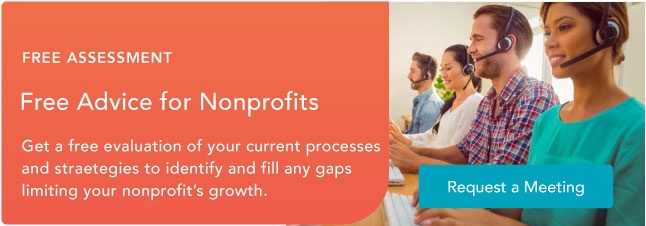The traditional forms of acquiring new applicants -- direct mail, billboards, paid advertising, prints ads -- are no longer working for many K-12 private schools. These methods are not measurable, very expensive, and the ROI is minimal -- if not negative.

Brendan Schneider, the director of admissions at Sewickley Academy (and a HubSpot all-star) put it perfectly, “It all came together that prospective families begin their search for schools at Google, and if you don’t show up on the first page, you might as well not exist.”
Your potential applicants and their families are also doing much more of their research before they even reach out to your school, pushing inquiries down to the bottom of your marketing funnel. If your school isn’t providing educational content about your classes, references from other parents, and ways to communicate and engage with your admissions office before they’re ready to apply, another competitive school in your area that is will most likely acquire that applicant.
But don’t worry. There's recourse.
Inbound Marketing and Your School
Using inbound marketing at your private school is about creating content that is going to be found by your target parents and/or students on Google and in social media. This content lives on your school’s blog and website, and is targeted at solving the problems and answering the questions your target audiences -- or personas -- are searching for online.
For example, if you're a private school in the Cambridge area, you should be building up your content around the keyword phrases like “private schools in Cambridge.” Many schools are writing content that is brand focused, constantly talking about information that is only relevant to those that already know about the school. Those that don't know about your school, but are looking for prospective private schools in their area, are searching for more general terms.
Now, I can talk all day about how you can use inbound marketing to increase your inquiries and applicants, but why not talk about a private school that is doing it already?
What You Can Learn From Sewickley Academy and Brendan Schneider
Sewickley Academy adopted inbound marketing back in 2008 after the recession, when they started to see their inquiries decline month after month. They tried throwing more money at traditional marketing channels, including billboards and direct mail, which didn’t increase any of their “interest indicators” -- inquiries, applicants and on-site visits -- and also left a big hole in their pockets.
Brendan was frustrated and started reading, a lot. He came across the inbound marketing book, and had his marketing "ah-ha" moment. He realized his school needed to stop talking about Sewickley, and start talking in general about private schools in the Pittsburgh area through online channels.
And that's exactly what he did.
Content Strategy
Brendan focused his content strategy by developing personas for different families in the area. He found that there were different personas based on where the family lived in relation to the school, i.e. North, South, closer to Pittsburgh, and right in the school’s neighborhood.
Then he came up with targeted keywords to create content around, primarily for their blog. They started writing blog posts that were helpful and provided solutions to a family’s problems and questions. The posts were roughly 300-600 words, focused on one topic that keyword research showed families cared about. Brendan also realized he's writing for people and even if the keywords don’t fit, he makes sure his content educates and entertains the audience. He also always provided a call-to-action at the end of the posts.
Using these tactics, the school continued to see success after six years of inbound marketing, reaching their almost-seven-year-high in inquires this year.
Brendan's best piece of advice for content: Make sure you are active with your community online, answering questions and providing useful information they need before they apply.
Paid Ads Strategy
Sewickley took advantage of Google ads and Facebook ads. In the beginning, Brendan targeted keywords and phrases that he was writing about so they could attract traffic while building up authority on the topics with organic blog content.
The key to Sewickley's paid ads success is that instead of dropping visitors on their homepage and letting them fend for themselves, Brendan tailored their ads to specific content and dropped the visitors on landing pages that were directly related to the ads.
On Facebook, Sewickley uses promoted and sponsored posts, avoiding the right sidebar of ads. In the ads, they promote their free content, including a simple top-of-the-funnel offer for “27 Questions to Help You Evaluate a School for Your Child.” This ad directs the visitor to a landing page where they download the piece of content and become a prospective applicant in Sewickley’s database. They also promote their events being held at the school, posting an engaging photo with the date and time of the event and using specific targeting to promote it locally.
Social Media Strategy
Social media really supports your content strategy and provides you with channels to promote it. It’s also serves as a retention tool, so you can easily engage with families and students.
Brendan is the sole marketer at the school, so he has learned how to manage his social media effectively. His advice is to schedule time to check social media and only check it at that time, because you can spend all day on all the different channels.
Brendan checks his social channels three times a day. In the morning, he schedules his posts for the day and responds to any messages, tweets, or comments he has. He then checks it during lunch, and then right before he leaves the office.
His advice for social media is to treat every channel separately and differently. Not all content will work on all channels in the same format and length. For example, he uses Instagram -- which has become more popular than Facebook for the teens since their parents are now saturating the channel -- to share photos quickly. But tou have to understand which channels will work best for your school and manage what you can. Don’t try to be on every single channel; you won't have enough time in your day and you'll end up managing all the channels only somewhat effectively.
Final Pieces of Advice
Based on Sewickley's success with inbound marketing, the best first step for anyone looking to get started with inbound or increase their applicant pool is just to get the inbound marketing book and start reading.
If you're already getting started with inbound or would like to start soon, get ready to start measuring everything you do. This includes what you're currently doing -- like direct mail or other more traditional marketing tactics. It'll make it far easier to make the case for inbound investment with comparative metrics.
For instance, Brendan did one final direct main campaign to 3,000 potential applicants for an event, which resulted in two people visiting the event page and zero people registering. Sewickley no longer does direct mail.
Finally, follow a lean business model. Cut the marketing tactics that don't have a positive return on investment, and invest small and iterate on what works.







![Building an Efficient Education Marketing Machine [Free Ebook]](http://53.fs1.hubspotusercontent-na1.net/hubfs/53/Education/Efficiencyhand.jpg)


